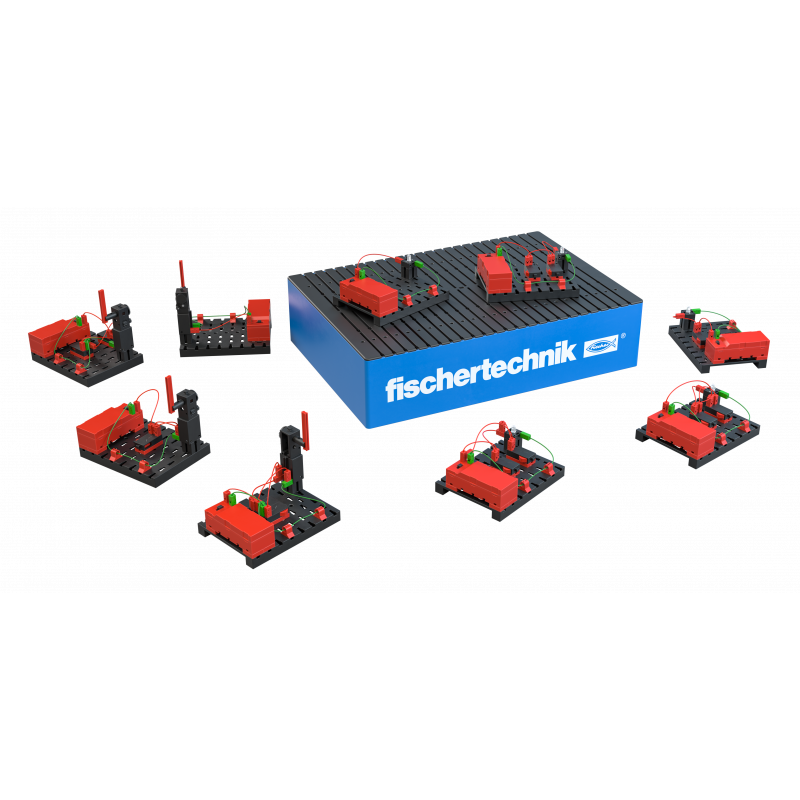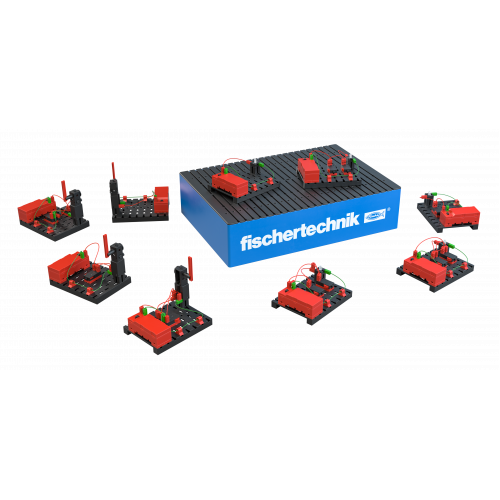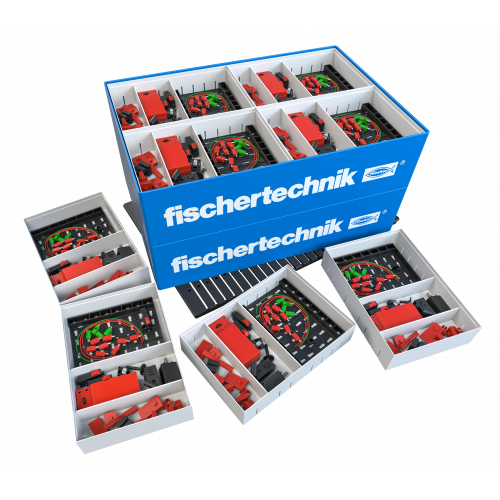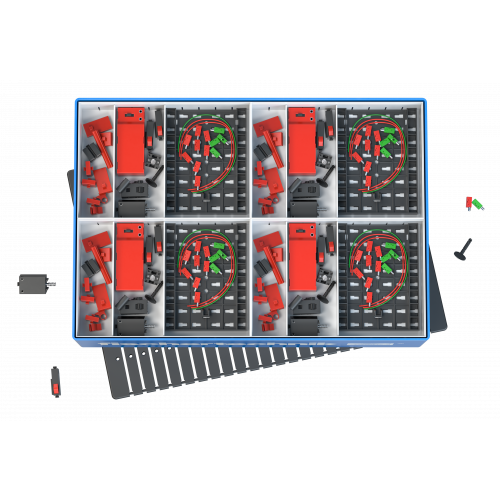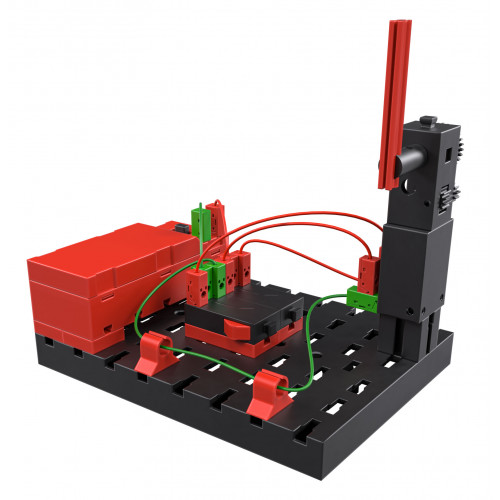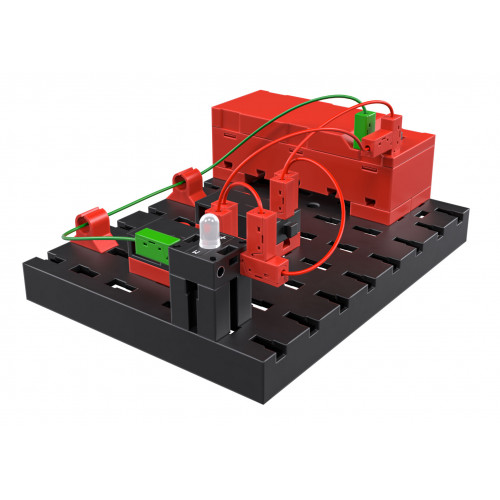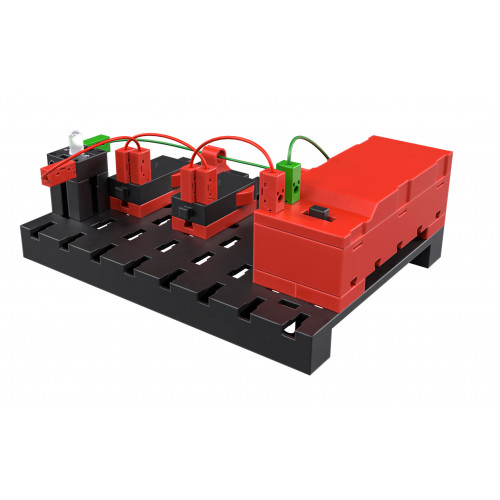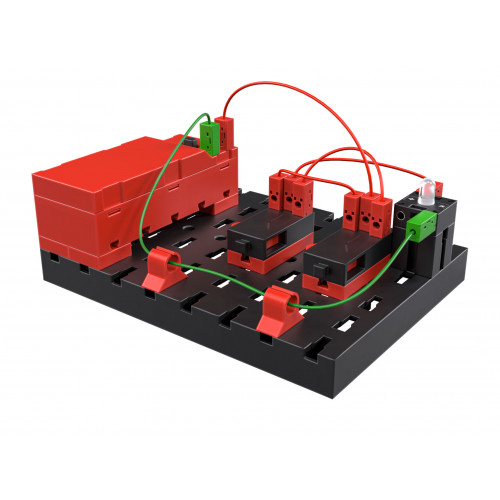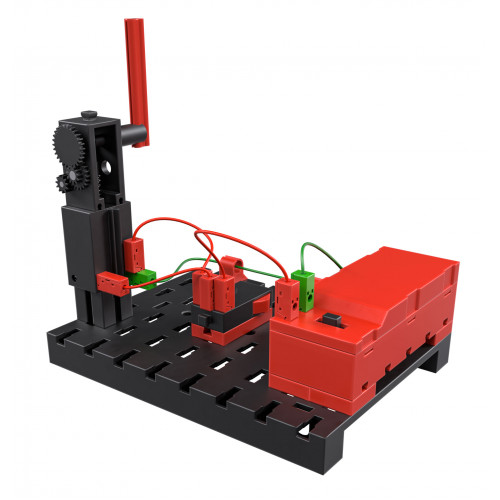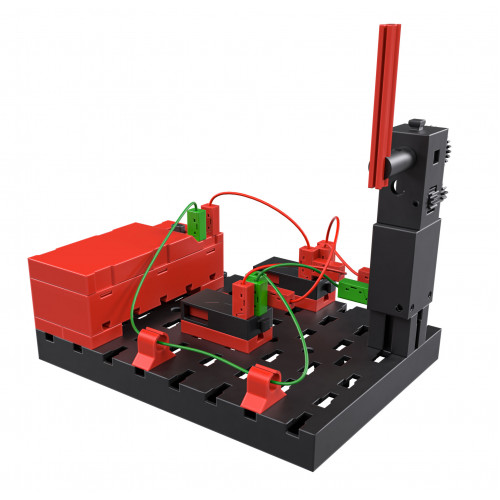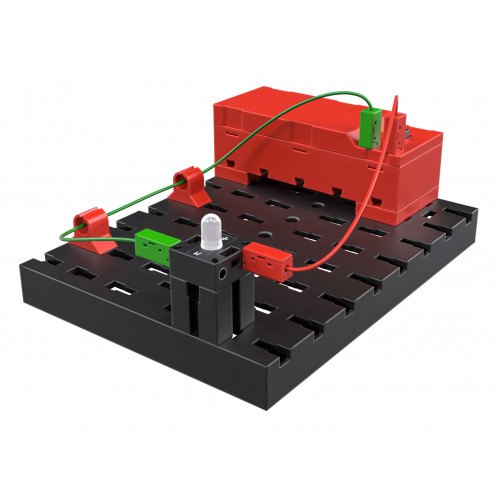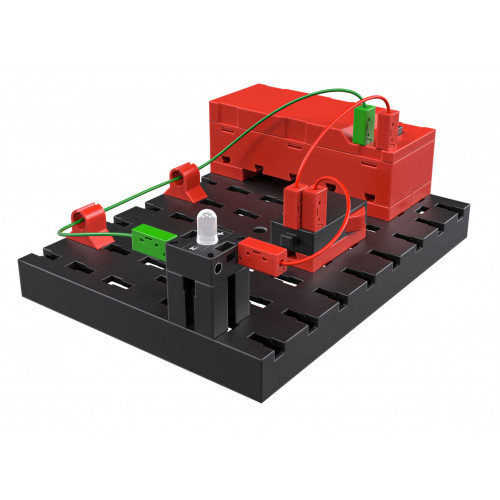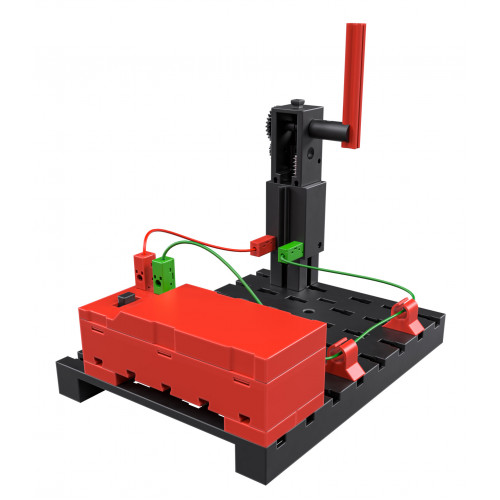CLASS SET Electrical Control
Are you a school or company and do you want to order on account? Please contact us.
Young inventors and researchers are curious, and question everything. How does the staircases light turn on? Why does it go on at the bottom, and back off again at the top? Children learn the answers to these and other questions in a fun way through our Class Set Electrical Control based on nine models and 25 experiments. The set teaches all about electrical circuits using simple applications in a way kids can understand. The models are easy to build in the classroom and integrate with fully designed tasks and solutions. A class set contains 16 individual sets and is suitable for 30 pupils and one teacher, for example.
Accompanying teaching material:
fischertechnik Education products include comprehensive, freely accessible teaching materials. These have been developed together with teacher training colleges, teachers and didacticians and are ideally suited to the needs of the classroom. In addition to the topic introduction, lesson plans with task sheets and educational plan references are available.
- The topic introduction provides content that can be optimally used for lesson preparation and integrated into the lessons. Definitions, history, basic knowledge and much more are provided.
- The teaching material includes an overview of the learning objectives as well as the time required for the tasks.
- In line with the curriculum-relevant topics, various tasks are included within which different experiments are dealt with.
- The tasks are divided into a construction task, thematic task and experimentation task. In this way, one progresses from building, to learning technical content, to applying the acquired knowledge.
• Electric charge and energy are stored in a power source, such as a battery. Electric charge can be either “positive” or “negative”. In a rechargeable battery, the energy comes from charging the battery.
• A device is the machine that uses the electrical power: A lamp lights up, a motor turns and is able to perform work.
• A circuit is created when the electric charge flows between two poles – a plus pole and a minus pole. The electric charge flows from the power source to the device and back. The energy flows with the current and is used by the device for its specific purpose. This is why batteries eventually run out (discharge).
• The current flows through electrical wires, such as a piece of metal in the form of a cable.
• Electric switches are used to control the flow of current. They connect or interrupt the current flow. This allows us to turn a torch or a motor on and off.
Electric current can transport energy very quickly across vast distances, and use it for a wide range of different purposes. That makes it versatile, and more useful than almost anything else on earth.
However, we have all probably had harmless experiences with electricity, such as when you comb your hair with a plastic comb and then see it “standing on end.” The hair is electrically charged due to the friction on the comb. Such effects were observed as early as 600 BC in case of friction with amber.
An early forerunner of the “battery” was produced during the last century BC: Two rods, one iron and one copper, were immersed in an electrolyte, as it is known today. At the time, grape juice was used for the electrolyte!
It has only been in the last approx. 400 years that electricity has been investigated systematically. Around the beginning of the 19th century, the interaction between flowing electric current and magnetism was discovered – the basis for later electric motors. British physicist Michael Faraday summarised the natural laws of electricity in mathematical formula. These made it possible to quantitatively calculate electrical phenomena.
Since that time, people have been gaining experience with electricity and creating new practical applications. New discoveries are moving faster and faster all the time. Think of the incandescent light bulb, the first telegraph, the first radio transmission, telephone, TV, electric trains and other vehicles, the pocket calculator – even up to telecommunications satellites, smartphones, microcontrollers and huge computing centres.
• The battery holder contains a 9 V block battery or rechargeable battery. It has an on/off/reverse polarity switch.
• A LED serves as the light source.
• A powerful, small, quiet electric motor to power the model. Since this is a direct current motor, its rotational direction can be changed by changing the polarity (reversing the connections).
• The fischertechnik button is a self-resetting switch that changes a “central” contact from a “break” contact to a “make” contact at the push of a button. It can be used to not only turn devices on and off, but also build refined control devices using suitable electrical switches.
• Cables with plugs are used to create the electrical connections between components.
Of course, all of these fit perfectly into the fischertechnik system, and can be used to not only illustrate basic electrical functions, but also create robust and realistic functional models of machines.
Accompanying teaching material:
fischertechnik Education products include comprehensive, freely accessible teaching materials. These have been developed together with teacher training colleges, teachers and didacticians and are ideally suited to the needs of the classroom. In addition to the topic introduction, lesson plans with task sheets and educational plan references are available.
- The topic introduction provides content that can be optimally used for lesson preparation and integrated into the lessons. Definitions, history, basic knowledge and much more are provided.
- The teaching material includes an overview of the learning objectives as well as the time required for the tasks.
- In line with the curriculum-relevant topics, various tasks are included within which different experiments are dealt with.
- The tasks are divided into a construction task, thematic task and experimentation task. In this way, one progresses from building, to learning technical content, to applying the acquired knowledge.
Electric circuits form the basis for countless devices, from simple light switches used to turn on indoor lights to kitchen appliances to robots and computers. Electrical phenomena and technologies can be vividly illustrated, experienced, and understood using low electrical voltages, for instance from a battery.
• How does a torch work?
• How do I turn an electric motor on and off?
• How can I change the rotational direction of a motor?
• How can I control a light from multiple points, for instance a stairwell light?
• How do simple electrical controllers work?
Definition
• Electric charge and energy are stored in a power source, such as a battery. Electric charge can be either “positive” or “negative”. In a rechargeable battery, the energy comes from charging the battery.
• A device is the machine that uses the electrical power: A lamp lights up, a motor turns and is able to perform work.
• A circuit is created when the electric charge flows between two poles – a plus pole and a minus pole. The electric charge flows from the power source to the device and back. The energy flows with the current and is used by the device for its specific purpose. This is why batteries eventually run out (discharge).
• The current flows through electrical wires, such as a piece of metal in the form of a cable.
• Electric switches are used to control the flow of current. They connect or interrupt the current flow. This allows us to turn a torch or a motor on and off.
Electric current can transport energy very quickly across vast distances, and use it for a wide range of different purposes. That makes it versatile, and more useful than almost anything else on earth.
History
However, we have all probably had harmless experiences with electricity, such as when you comb your hair with a plastic comb and then see it “standing on end.” The hair is electrically charged due to the friction on the comb. Such effects were observed as early as 600 BC in case of friction with amber.
An early forerunner of the “battery” was produced during the last century BC: Two rods, one iron and one copper, were immersed in an electrolyte, as it is known today. At the time, grape juice was used for the electrolyte!
It has only been in the last approx. 400 years that electricity has been investigated systematically. Around the beginning of the 19th century, the interaction between flowing electric current and magnetism was discovered – the basis for later electric motors. British physicist Michael Faraday summarised the natural laws of electricity in mathematical formula. These made it possible to quantitatively calculate electrical phenomena.
Since that time, people have been gaining experience with electricity and creating new practical applications. New discoveries are moving faster and faster all the time. Think of the incandescent light bulb, the first telegraph, the first radio transmission, telephone, TV, electric trains and other vehicles, the pocket calculator – even up to telecommunications satellites, smartphones, microcontrollers and huge computing centres.
Fundamentals
The following components are used for an introduction to electricity and electrical engineering with fischertechnik:• The battery holder contains a 9 V block battery or rechargeable battery. It has an on/off/reverse polarity switch.
• A LED serves as the light source.
• A powerful, small, quiet electric motor to power the model. Since this is a direct current motor, its rotational direction can be changed by changing the polarity (reversing the connections).
• The fischertechnik button is a self-resetting switch that changes a “central” contact from a “break” contact to a “make” contact at the push of a button. It can be used to not only turn devices on and off, but also build refined control devices using suitable electrical switches.
• Cables with plugs are used to create the electrical connections between components.
Of course, all of these fit perfectly into the fischertechnik system, and can be used to not only illustrate basic electrical functions, but also create robust and realistic functional models of machines.
| fischertechnik construction kit information | |
| Number of parts | 34 (x16 Sets) |
| Number of models | 9 |
| Contents fischertechnik CLASS SET Electrical Control | Download |

























